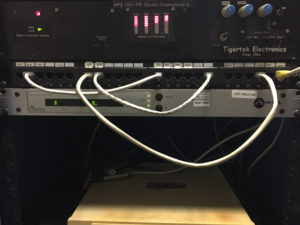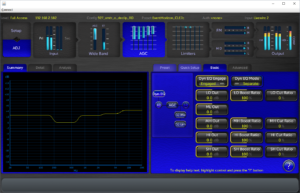These presets are designed to take advantage of the advances presented in the upcoming version 3.6 release of the Omnia.11 G-Force audio processor.
Important:
Continue reading “DynaClear presets for Omnia.11 G-Force Version 3.6”Broadcast And New Media Technical Services
These presets are designed to take advantage of the advances presented in the upcoming version 3.6 release of the Omnia.11 G-Force audio processor.
Important:
Continue reading “DynaClear presets for Omnia.11 G-Force Version 3.6”Presets designed to operate with the original Omnia.11 clipper (pre-version 3.5), the presets were tweaked around the “brightness density” of the old clipper. This “brightness” of the older clipper comes from the way high frequency distortion products were handled. The newer clipper produces very little of these products, and as a result, sounds much “smoother”. Some may perceive this this smoothness as a “duller” sound.
Fortunately, there are a couple of tricks to do right away to bring back some of the effect…albeit with MUCH cleaner results than the old clipper! Continue reading “Using G-Force presets designed before version 3.5”
Urban / Urban AC presets
These presets are designed for Urban / Urban AC / Pop Music /  CHR. They feature a distinctive low-end (bass) character, and a mellow sounding high end (treble).
CHR. They feature a distinctive low-end (bass) character, and a mellow sounding high end (treble).
These presets will ONLY work in G-Force, and will only sound correctly when used with G-Force version 3.5(75) or higher. Continue reading “Cornelius Gould Omnia.11 G-Force presets for Urban AC / Urban / CHR / Pop Music Leaning formats”
Omnia.11 G-Force version 3.5 Hot / CHR / Urban Leaning presets
Here are a few presets initially designed around Hot Pop music formats, and will also work well with other formats as well.
Because of the bass texture, these presets make great candidates for Urban or Urban leaning formats as well! These presets will ONLY work in G-Force, and will only sound correctly when used with G-Force version 3.5(75) or higher. Continue reading “Cornelius Gould Omnia.11 G-Force Hot / CHR / Urban Leaning presets”
ADJUSTING THE “HIGH END” (TREBLE) CHARACTERISTICS (OR SOUND) OF A PRESET
 In general, I design presets to have some sort of a “middle ground” sound. Not too much high or low end, and not too little. Exactly what that means is highly subjective.
In general, I design presets to have some sort of a “middle ground” sound. Not too much high or low end, and not too little. Exactly what that means is highly subjective.
With the above in mind, there are several options to allow end users to tailor the sound of a preset to their tastes, or to the tastes of the market they are in.
These suggestions apply only to the G-Force (blue design screen) versions of the Omnia.11, not the “Orange Screen” design version! Continue reading “Tweaking Omnia.11 G-Force presets”
I’ve always loved the sound of processed audio. I’m a big fan of it! The only thing that I do not like about processing audio is hearing the audio processor work. My life goal when developing audio processing is to create well managed audio, but I don’t want to hear the audio processor working to make the effect happen!
The serious pursuit of this goal started late in 1987 when development of my first multiband audio processor began. A short series of multiband designs were developed, all leading to The Audio Chameleon audio processor (APS-1000), which debut around 1990.
This is an off-air audio cassette sourced clip of the early version of the FM Audio Chameleon. This clip features the young version of me as the DJ on my “pirate” FM station. This clip is from around 1991:
There were several versions of the Audio Chameleon produced between 1990 and the last one in 2005. The 2005 model (which still exists) was the last to feature CMOS “hard coded” logic.

I knew the next step would be in the digital domain, where I can just make use of the computers built into the hardware. Why? Because it was obvious to me that the answer to invisible control was more intelligence.
The Omnia.11 version 1.x series processor (which I now nick name as Omnia.11 “Orange Screen”) was the first step. Development on the Continue reading “Omnia.11 G-Force: The background story…Part 1”
Omnia.11 G-Force version 3.5 Rock / AAA / AC presets

Here are a few presets initially designed around Triple-A (AAA) / Alternative music formats, and will also work well with Rock, AC, and Country Music formats. These will ONLY work in G-Force, and will only sound correctly when used with G-Force version 3.5(75) or higher. These presets are NOT “over the top loud”, though they will let the “impact” through when music density naturally intensifies. Continue reading “Cornelius Gould (CG) Omnia.11 G-Force Rock / Adult Alternative Music Presets.”
Omnia.11 G-Force version 3.5 pop music genre presets.
Here are some specialty CHR / Pop Music presets that I designed to use with Omnia.11 G-Force version 3.5(75) or higher. These will ONLY work in G-Force, and will only sound correctly when used with G-Force version 3.5(75) or higher. Continue reading “Cornelius Gould (CG) Omnia.11 G-Force Pop Music Genre presets”
Omnia.11 G-Force is a major update to the dynamics engines. This “plugin” replaces the wideband AGC, Multiband AGC, and multiband limiter algorithms. Most notable in this change is the fact that the limiters now have powerful intelligent control over their activities. This means the new multiband limiters act in a very “positive” way, and also features extremely low IMD in the process. This means there is greater clarity, punch, and detail that comes through vs. the standard “stock” dynamics core. Live voices punch through more, and are better protected from clipper-induced distortion.

There is also a dynamic equalizer section that does NOT use compression for its operation. It provides a high level of spectral consistency from source-to-source without ruining dynamics Continue reading “What is Omnia.11 G-Force?”
Bass Clippers — an overview
By Cornelius Gould
Whenever audio is “clipped”, it is literally “distorted”. This distortion is very similar to what is used for that big LOUD rock guitar sound. The key to broadcast processing is to do this without the distortion being audible. Clipping in broadcast audio give the audio more “impact” and in most cases also boosts perceived loudness.
The Bass clippers probably came to prominence with the introduction of Bob Orban’s Optimod 8100 audio processor.
In the 8100, the purpose of the bass clipper in the 8100 is to more-or less allow the bass processor to run at a more natural rate. This rate means that the attack time is somewhat slow. Slow attack times means that you sometimes get large peak excursions that must be dealt with to control modulation. The cleverness of the 8100 is this: The peak is allowed to happen, but it is “chopped” off by the bass clipper. This provides instantaneous compression of the bass audio. Without losing bass “impact”. This is cool, but that’s not all! Continue reading “What does a “Bass Clipper” do?”